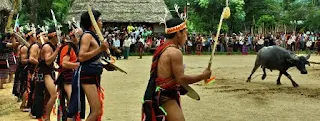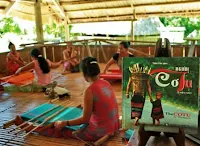 The Cotu People - Quang Nam Province, Vietnam
The Cotu People - Quang Nam Province, VietnamThe Co Tu minority is one of the smallest of the 54 ethnic groups of Vietnam and is part of the Mon-Khmer ethnic language group. There are fewer than 60,000 Co Tu people with the majority living in the highlands of the central provinces of Quang Nam and Thua Thien.
Perhaps one of the most infamous facts about the Co Tu people is their reputation for head hunting. While this practice, referred to as ‘blood hunting’ in the local dialect, was abandoned in 1953 the Co Tu were the last tribe in Southeast Asia to partake in such an activity earning them a dubious reputation. However the reasoning behind their beliefs were just: in times of extreme hardship, when women were grossly outnumbered by men, the men fought to the death for the rights to marry and procreate.
Cotu Villages Festival. Song Con. Dong Giang. Quang Nam
Co Tu Village Life
The village layout of the Co Tu people is one of their distinctive characteristics. Each village contains around 30 stilted houses which are built side by side on a slight curve creating a crescent shape. In the center of the crescent is the communal house, or guol, the largest building in the village. The guol serves as the social, religious and cultural center and is used for the reception of guests, to hold meetings, rituals and performances. Symbolically the guol represents the soul of the village and towers over the other houses and the larger the guol, the more prosperous the village.
As they have for centuries, the Co Tu are an agrarian people who live off the land. They practice slash and burn cultivation and are skilled hunters and fishermen. Animal husbandry, cloth weaving and weaving jute baskets are also common activities of the Co Tu. These goods are then bartered and traded within the village and with neighboring villages.
Co Tu people follow a patriarchal pattern with the men being responsible for the household, making the decisions and holding political power while the women are responsible for looking after the family and the agricultural work. The Co Tu believe that souls wander the earth around them and since women are believed to be weaker, it is thought that these floating souls can permeate and talk to the women thus granting them special spiritual powers.
The Co Tu worship Giang, or genie, and every house has a special alter dedicated to Giang upon which they place horns and heads of hunted animals. A yearly celebration in honor of Giang is held in the late summer and is marked by the slaughtering of a sacrificial animal. During such festivals, and at other celebrations throughout the year, the Co Tu perform their traditional dances: tung tung for the males and ya ya for the females.
Dress
The traditional dress of the Co Tu people is simple and practical, yet colorful. The men wear loincloths and leave their upper bodies bare except during ceremonies when they drape a scarf in a cross across their chest. The women wear long skirts and short-sleeved tops. Both men and women’s outfits are made from black fabric with bands of embroidery predominately in red, white and orange. They are the last tribe in Southeast Asia who continue to embroider their beads by hand, having yet to accept the use of glue for this process.
Traditionally face and body tattooing were common among the Co Tu people as well as filing of the teeth. Over time, however, this aspect of Co Tu culture has begun to fade and is rarely seen on the younger generations.
Beads Weaving, Co Tu Unique Crafts Named Vietnam Heritage Texible
Beads woven into cloth is the unique style of Ca Tu weaving. Each motif has its own name and special significance, representing different animals, heavenly bodies, or the daily life of Ca Tu people and Ca Tu culture.
 Every motif is formed with the same meticulous care by first threading particular beads onto a weft. Then, during the weaving process each bead is carefully placed into the exact position to form the design. It is a process that only the most skilled and experienced weavers can accomplish, and we believe you will be delighted by the finished products with their beautiful designs.
Every motif is formed with the same meticulous care by first threading particular beads onto a weft. Then, during the weaving process each bead is carefully placed into the exact position to form the design. It is a process that only the most skilled and experienced weavers can accomplish, and we believe you will be delighted by the finished products with their beautiful designs.Each motif has its own name and meaning, representing natural phenomenon (Star, Spider, lizard…) , daily life of Catu people ( Ta Tot leave…) or Catu culture (Catu dancing style…)
Soure: Mr. Ngo Cong Thanh. FIDR Vietnam
With our passion and understanding, we would love to share and connect to ones who love and concern of preserving, development of Cotu lifestyles, culture, traditions,.
Just hat off for few days up to the mountains and you may fall in love with Cotu unqiue culture, certainly with friendly people.



















0 Comments